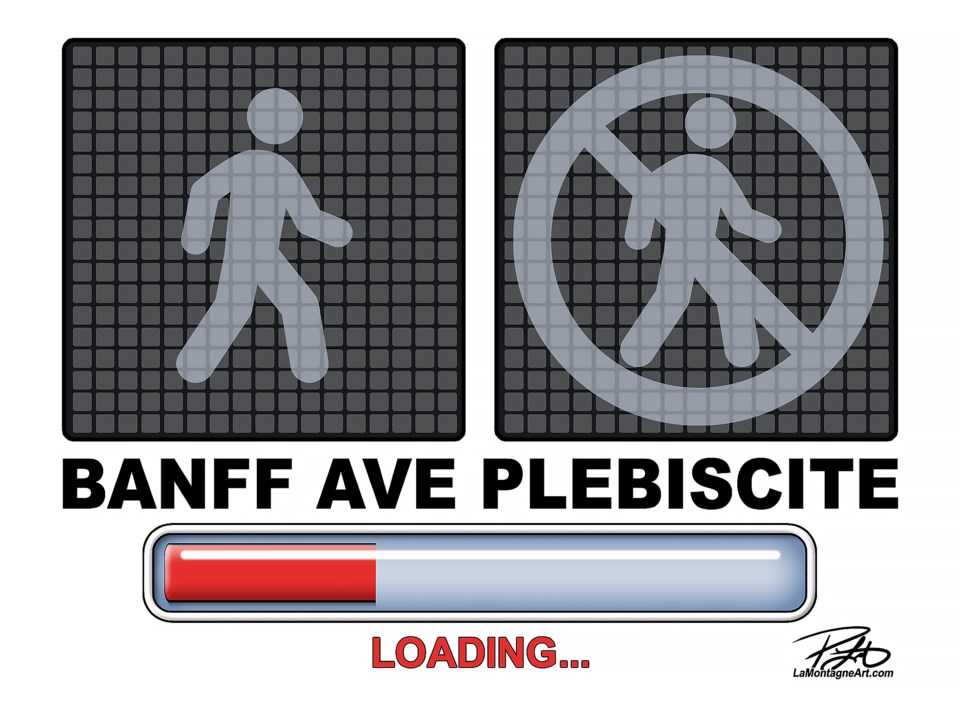A final and decisive answer is on the horizon for the Banff pedestrian zone.
Set to take place August 12, roughly two-thirds of the way through the pedestrian zone season, a binding plebiscite will answer what has become a polarizing issue for Banffites.
Whether or not a pedestrian zone continues is unknown until those votes are counted, but it brings forward jurisdictional issues and the role of council in a municipality.
Council’s main purpose is to make what it believes are the best decisions for the community in both the present and future.
The decision to continue the pedestrian zone was by no means unanimous among council members, but few decisions are meant to be such since each elected official will have its own base from the community to represent.
The majority, if not all, of those decisions will be polarizing in some capacity.
Council is designed to make those decisions after hearing from the public and analyzing all information possible before potentially directing municipal staff for the best use of public funds.
If residents dislike decisions made by council members, every four years they can head to the polls to have the opportunity to find others they think can do a better job.
However, the Municipal Government Act allows residents to take quicker action by gathering 10 per cent of the population to press an issue.
The pedestrian zone has been a lightning rod in Banff for those living in the community, and, for Parks Canada.
The pedestrian zone came into existence during the COVID-19 pandemic to give space when public health guidelines were in place to safely enjoy parts of downtown Banff.
The zone, however, remained after the pandemic and public health regulations were ended.
In recent years, the Outlook has written multiple editorials praising both Canmore’s and Banff’s pedestrian zone. It not only allows for businesses to enhance outdoor services, but can create a gathering space for community and offer an area for residents and visitors to enjoy.
Though common in European communities, which often have planning designs made around such spaces, it’s still relatively new for Canadian municipalities.
Like it or not, people are going to only come in greater numbers to Banff.
Issues raised by residents are very real and need to be considered, listened to and mitigated as best as possible.
From concerns of the closed area delaying evacuation, vehicle traffic being pushed to neighbouring residential streets and Parks Canada’s belief it circumvents federal legislation with the commercial cap, solving the issues take more than a few conversations.
In neighbouring Canmore, its pedestrian zone grew some consternation in the early days since parking was removed from two blocks of Main Street. But in the last year, there’s been little talk of removing it.
Except for one letter to the editor in the Outlook last year asking for more flowers and artwork to be put on display, Canmore’s pedestrian zone has been a hit for residents and visitors.
In Banff, it was a contentious enough decision to have 11.5 per cent of residents – more than 1,000 people – push forward with a plebiscite allowed under provincial law and challenge whether council made the correct decision to continue the zone.
To get 10 per cent of a population to agree on bringing forth a possible change, let alone the logistics in doing such a role, is impressive. The work to get to this stage of a rare plebiscite showcases the need to give the community a final say to decide if the pedestrian zone continues or not.
But a plebiscite also brings issues of who can and can’t vote. With 76 per cent of Banff residents being Canadian citizens and eligible to vote, it leaves a quarter of the community on the outside looking in.
Regardless of the outcome of the August vote, a council should maintain the jurisdiction and authority given to it under provincial law.
But those same laws allow residents to question a council decision and send it back to residents to determine whether it was right or wrong.




